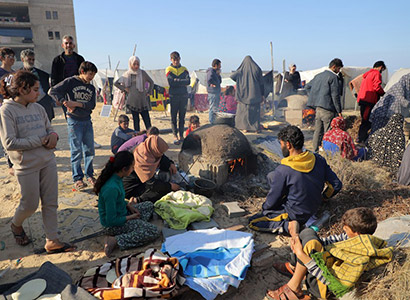 |
| Displaced Palestinians prepare food at a temporary shelter in the southern Gaza Strip city of Rafah, on Dec. 18, 2023. |
WHO says humanitarian, medical situation “dramatically bad” in Gaza
GENEVA (Xinhua) -- The World Health Organisation (WHO) warned of a humanitarian and health catastrophe in the Gaza Strip on Tuesday as humanitarian space and access to medical services continue to shrink.
Speaking at a United Nations weekly briefing via video link from Gaza, Sean Casey, WHO emergency medical teams coordinator, highlighted the “dramatically bad” situation in the entire Gaza Strip. The health system is collapsing rapidly, and there has been no letup in the intensity of conflict over the past weeks, he said.
“Hospitals are closing, patients are lacking access to health facilities, health workers are being forced to flee for their safety,” Casey said.
The bloody fighting has intensified in central and southern areas, straining over-burdened hospitals that remain open.
The three most important hospitals in those areas, European Gaza Hospital, Nasser Medical Complex and Al-Aqsa, were the lifeline for south Gaza which was currently sheltering over two million people, said Richard Peeperkorn, WHO representative in the occupied Palestinian territory.
The Al-Aqsa hospital lost 70 percent of its staff, who fled with families for safety reasons, as did Nasser Medical Complex, one of the last trauma cnetres in service. The evacuation of medical staff has made hospitals non-functional.
Thousands of patients left Al-Aqsa for other hospitals which were already bursting at the seams. They were only moving from one bad situation to another, as there were no safe places in Gaza, Casey said.
Compared with 3,500 hospital beds prior to the conflict, Gaza has only around 1,400 now, but the situation required at least 5,000, said Peeperkorn.
The conflict has displaced 1.9 million people, a staggering 85 percent of Gaza’s population, and left civilians in the besieged Palestinian territory at risk of famine and disease, said the United Nations.
The WHO, together with the UN Relief and Works Agency for Palestinian Refugees, tried to assess the levels of infectious diseases, saying more than 81,000 cases of diarrhea have been recorded, up from 2,000 in normal times.
The resolution adopted by the WHO Executive Board last month called for immediate, sustained and unimpeded passage of humanitarian relief in Gaza, but humanitarian access has become even more limited. Every day, aid deliveries in Gaza were being denied, said Peeperkorn.
WHO has been denied access to the north for two weeks and was forced to cancel six planned missions. The team was ready to deliver aid but had not been able to receive the necessary permissions.
“Every day we line up our convoys, we wait for clearance and don’t get it,” Casey said. “And then we come back and we do it again the next day.”
Speaking of children who had limbs amputated, Casey said the amputations were happening due to delayed access to care and the lack of resources at hospitals.
There was also a lack of surgeons and operating space. With the limited resources, Peeperkorn said the medical staff constantly had to make tough choices, including doing amputations that should have been unnecessary to save as many lives as possible.
(Latest Update January 11, 2024)
|